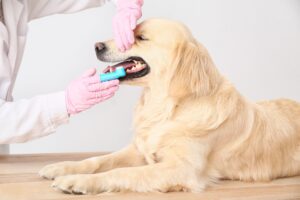Understanding Dental Disease in Dogs
 As pet owners, we often focus on providing our furry companions with proper nutrition, exercise, and regular veterinary care. However, one aspect of their well-being that often goes unnoticed is dental health. Just like humans, dogs are prone to dental disease, which can lead to discomfort, pain, and various health issues if left untreated. In this post, we will delve into the common dental diseases in dogs, their causes, symptoms, and preventive measures.
As pet owners, we often focus on providing our furry companions with proper nutrition, exercise, and regular veterinary care. However, one aspect of their well-being that often goes unnoticed is dental health. Just like humans, dogs are prone to dental disease, which can lead to discomfort, pain, and various health issues if left untreated. In this post, we will delve into the common dental diseases in dogs, their causes, symptoms, and preventive measures.
Periodontal Disease: The Most Common Dental Disease in Dogs
Periodontal disease is the most prevalent dental condition in dogs. It begins with the buildup of plaque, a sticky film composed of bacteria, saliva, and food particles, which eventually hardens into tartar. Tartar accumulation irritates the gums, leading to inflammation known as gingivitis. If not addressed, the condition progresses to periodontitis, where the gums recede, tooth roots become exposed, and infection can set in.
Causes and Risk Factors of Dental Disease in Dogs
Several factors contribute to the development of dental disease in dogs. Poor dental hygiene, lack of regular tooth brushing, and inappropriate diets high in carbohydrates and sugars can increase the risk. Additionally, certain breeds, such as small dogs and brachycephalic breeds, are more susceptible due to their crowded teeth and unique jaw structures. Age, genetics, and overall health also play a role in dental health.
Recognizing the Signs of Dental Disease in Dogs
Detecting dental diseases in dogs can be challenging since they often hide discomfort or pain. However, there are some signs to watch out for, including:
- Bad breath (halitosis)
- Red, swollen, or bleeding gums
- Discolored or loose teeth
- Excessive drooling
- Difficulty eating or loss of appetite
- Pawing at the mouth or face
- Changes in behavior or mood
Prevention of Dental Disease is Best for Your Dog
Preventing dental disease in dogs starts with establishing a regular dental care routine. Here are some preventive measures you can take:
1. Brushing
Get your dog accustomed to regular tooth brushing using a dog-friendly toothbrush and toothpaste. Start gradually and reward positive behavior.
2. Dental Diets and Treats
Opt for specially formulated dental diets and treats that promote chewing and help reduce plaque and tartar buildup.
3. Dental Toys
Provide your dog with appropriate chew toys designed to promote dental health. These toys can help massage the gums and clean the teeth.
4. Regular Veterinary Dental Check-Ups
Schedule routine dental examinations with your veterinarian. They can perform professional dental cleanings if necessary and identify any dental issues at an early stage. If you’re in Tampa, Affordable Pet Hospital is available to help you with all your dog’s dental health needs!
5. Maintain a Balanced Diet
Feed your dog a nutritionally balanced diet that supports overall health, including dental health.
Professional Dental Cleanings
In some cases, professional dental cleanings under anesthesia may be required to address severe dental disease. During these cleanings, the veterinarian will remove tartar and plaque, polish the teeth, and perform a thorough oral examination.
Dental Disease Care and Prevention in Tampa
Dental disease in dogs is a common yet often overlooked aspect of their overall health. Regular dental care and veterinary guidance will not only improve their quality of life, but also prevent the progression of dental disease and potential associated health issues. Remember, a healthy smile leads to a happy and vibrant dog! To find out more about how Affordable Pet Hospital can help you care for your dog’s dental health, give us a call at 813-991-9898 or contact us online.

